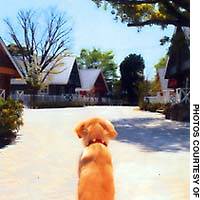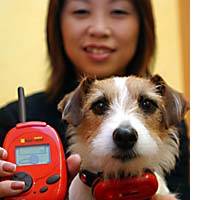A dog's life in Japan can be about as close to canine heaven on earth as it gets.
Sure, just like anywhere, there are losers, too -- the unfortunate ones who are abused, neglected or abandoned to their fate, perhaps passing through a pound before being put down. For the vast majority of pampered metropolitan mutts, though, being a "companion animal" means being treated like a royal baby, with no expense or effort spared to ensure they lead long and happy lives.
It's all a long way from the country's agrarian past, when Japan was not a particularly dog-friendly place. In those days, most animals were kept as guard dogs, and even today the lot of a countryside canine can be a miserable one.
Modern city-dwellers, though, live remote from nature and the countryside, and their dogs are sharing their chic urban lifestyle. Hotels, inns and restaurants increasingly accept pets along with their owners -- and there even special cafes, restaurants and hotels opening to cater for the dogs themselves.
Not for the first time, Japan is experiencing a "dog boom," with cute specimens fueling the frenzy as stars of popular ad campaigns. Plenty of people -- from breeders and retailers to vets and accessory-makers -- are cashing in along the way.
That the business is booming is clear from data kept by the Japan Kennel Club, which maintains the central register of pedigree dogs. This shows that the number of registered pure-bred dogs in Japan more than doubled from 259,054 in 1990 to 537,648 in 2002, while the number of breeds kept here rose from 106 to 149 during the same period.
However, among these breeds, a JKC spokesman pointed out, popularity is forever waxing and waning in response to media-led fads and as people's lifestyles and housing conditions change.
When Japan was surging economically in the 1970s, Pomeranians, Maltese and Yorkshire terriers were the top three dogs in fashion, together accounting for almost half of all JKC registrations during that decade. This, the spokesman explained, was due to people's limited housing space at that time.
Then came the bubble economy of the 1980s, when rocketing asset values propelled legions of Japanese not only into more spacious homes but also overseas on holiday for the first time. In the process, they encountered many new dog breeds. Consequently, that decade's most popular breeds were large, exotic dogs such as Afghan hounds, chow-chows and shih tzus.
Though the bubble burst in 1991, the trend toward bigger breeds continued for much of that decade, with golden retrievers, Labrador retrievers and Siberian huskies leading the pack. According to the JKC spokesman, however, the pendulum has now swung abruptly to the other extreme, with tiny breeds such as miniature dachshunds and Chihuahuas surging in popularity thanks to their cute appearance and playful nature.
"Many people used to keep dogs to provide security, but these days more and more people regard pets as companions that share completely in family life," the spokesman said. "And with an increasing number of condominiums now accepting pets, this has accelerated the trend toward keeping smaller dogs indoors."
Also, crucially influencing that trend has been a series of TV commercials for the consumer-loan company Aiful Corp. that feature a tiny, delicately built female Chihuahua called Ku-chan. Ever since her debut at age 16 months in August 2002, the kawaii canine has won millions of fans and sparked a crazy Chihuahua-owning boom that by the end of that year had taken the breed to second position in the JKC rankings, with 57,928 registrations, after the 157,362 registrations for miniature dachshunds.
Not surprisingly, Chihuahuas' current trendiness has sent their price soaring. On average, puppies aged 2 to 3 months are now selling from 270,000 yen to 500,000 yen, which is twice the price of three years ago. Golden retrievers, on the other hand, are now going for between 160,000 yen and 270,000 yen, which is 20 to 30 percent less than three years ago.
"In general, small breeds are now more expensive than larger ones," a staff member at pet-shop chain Kojima Co. confirmed. However, he also explained that "the prices fluctuate drastically. Popular breeds that only have litters of two or three puppies tend to be more expensive simply because of supply and demand."
In Japan, puppies are distributed through pet auctions held regularly across the nation, or through direct negotiations between breeders and pet shops. Their wholesale prices are about half or one third of the retail prices. In the case of Chihuahuas, for example, current auction prices range between 100,000 yen and 200,000 yen.
"But we are not making an easy profit," said a pet-shop owner in Tokyo. "After we buy puppies, we have to pay for food, veterinarian's bills for routine vaccinations, and personnel costs to take care of the animals. In addition, some might die before being sold, so the prices also include our compensation for the possible loss."
With total pet sales now topping 400 billion yen annually, there are, unfortunately, also regular reports in the media about profit-obsessed breeders and pet-shop owners.
Some breeders, it appears, force male dogs to work as full-time studs, turning their kennels into puppy factories, and some hardly feed their puppies so that they grow slowly and look younger and more appealing for longer -- and so command a higher price. Amateurish breeders hoping to cash-in quick are also blamed for producing dogs with physical problems.
Similarly, unscrupulous or ignorant pet-shop owners are now also often the subject of complaints to consumer centers or pet associations nationwide, with consumers not uncommonly reporting that their pets died or became sick soon after they bought them.
Meanwhile, pet-lovers also often voice concern over the conditions in which animals are kept in pet shops. At one Tokyo pet shop that stays open until 2 a.m., for example, a dog was seen lying in a small transparent cage under a fluorescent light day after day without anything to play with or even a water dish.
Sadly, this is far from being uncommon, and according to Yuri Shirai, an inspector for the Japan Animal Welfare Society, "the blame for this situation lies at the door of those who have failed to enact appropriate regulations governing pet dealers."
In general, Japan's legal framework regarding animal welfare lags far behind other advanced countries. In fact it wasn't until December 2000 that the Environment Ministry finally enacted the Animal Protection Law, which requires pet dealers to register with their local government. As of April 2002, a total of 13,781 dealers nationwide had done so. However, industry sources suggest the actual number of people operating as pet dealers exceeds 20,000, as they say there is effectively nothing to stop anyone going into the business without registering or getting a license.
In an effort to improve the standards of pet dealers, and to create a healthy environment for the industry, the Japan Pet Retailers Association, which was established in April 2001, last year published a set of professional guidelines. With these as a foundation, next year the association plans to introduce a qualifying examination for pet dealers, and to issue a certificate to those who pass, to distinguish them from backyard dealers.
In addition, the association has also banned its members from engaging in the online sale of pets, or their sale through Internet auction sites. "It is absurd to purchase a live animal without meeting it," said Osamu Suematsu, chairman of the association. "It is always necessary for consumers to ask to see the parent animals and their documents to check if a puppy might be at risk of suffering from a congenital disease."
In Japan, dogs for sale are generally put in glass cages and displayed near the shop's windows to catch the attention of passersby. Because their attractive appearance is a strong selling point, the average age of puppies at many pet shops is around 2 months -- which is equivalent to the weaning period for an infant.
However Suematsu, who is also president of pet-park operator M.K. Suematsu, said that it is necessary for puppies to be with their mother and siblings in their litter until they are at least 3 months old. "By that time, they will be ready to become independent and will have learned how to live in a community," he said.
At his newly opened facility, Dog Forest, on the Izu Peninsula in Shizuoka Prefecture, visitors can enjoy watching puppies they have reserved at a very young age as they spend their early months with their own kind. When the pup is a suitable age, its owners are taught how to train it. Only after that, when both humans and dog are ready, are the new owners free to take their pet home. In this way, Suematsu said that buyers learn how to live with their dogs.
He pointed out the added advantage of his system in preventing the impulse purchase of pets -- a phenomenon over which there is growing concern, as such animals are frequently abandoned or neglected when their novelty wears off.
Nationwide, more than 400,000 dogs and cats are destroyed at public facilities every year after being brought in by their owners or caught as strays. Although the death toll has fallen a little of late, in fiscal 2001 some 124,041 dogs died at such centers.
In Tokyo alone, 4,330 dogs were captured that year. They were then kept at the so-called Animal Protection Center in Setagaya Ward for seven days, during which time some were claimed by their owner, some were taken (free) by new owners and some were transferred to experimental research institutes. Most, though, were killed in carbonic acid gas chambers at the center's Ota Ward facility.
"We wonder if owners have a sense of morality," said a staff member at the center. "Many of the animals that end up here have simply been let loose or abandoned on beaches or in the mountains."
However, Shirai of the Japan Animal Welfare Society, which cares for abandoned or ill-treated animals and finds people to adopt them, was pleased to report that the organization has recently been receiving an increasing number of inquiries from people willing to give dogs new homes. Until three years ago, she said they only had about 70 such inquiries a year, but in fiscal 2002 that went up to 127, and she expects the figure for fiscal 2003 (which ends in March) to be even higher.
Shirai recognizes that some owners may feel compelled to give up their pets under certain circumstances: if they move to somewhere where animals are not allowed; if their company goes bankrupt and they can't afford the upkeep; or if they are divorced or hospitalized. However, she is keen to stress that being a dog-owner is a highly responsible role that takes both time and money.
"People should not keep dogs simply because they are lovable creatures," she said. "The cost of your pet does not end when you leave the pet shop. You have to pay for its food, veterinary bills, health supplements, vaccinations and so on. . . . And most importantly, you have to take responsibility for its life."






















With your current subscription plan you can comment on stories. However, before writing your first comment, please create a display name in the Profile section of your subscriber account page.